Related Research Articles
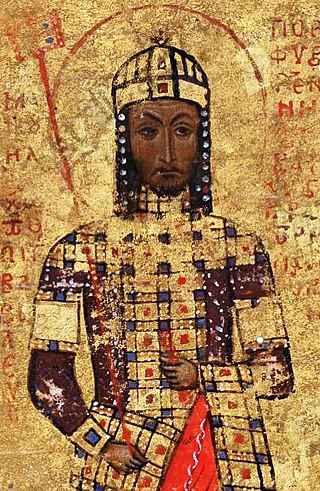
Manuel I Komnenos, Latinized Comnenus, also called Porphyrogennetos, was a Byzantine emperor of the 12th century who reigned over a crucial turning point in the history of Byzantium and the Mediterranean. His reign saw the last flowering of the Komnenian restoration, during which the Byzantine Empire had seen a resurgence of its military and economic power and had enjoyed a cultural revival.

The Second Council of Constantinople is the fifth of the first seven ecumenical councils recognized by both the Eastern Orthodox Church and the Catholic Church. It is also recognized by the Old Catholics and others. Protestant opinions and recognition of it are varied. Some Protestants, such as Calvinists, recognize the first four councils, whereas Lutherans and most Anglo-Catholics accept all seven. Constantinople II was convoked by the Byzantine Emperor Justinian I under the presidency of Patriarch Eutychius of Constantinople. It was held from 5 May to 2 June 553. Participants were overwhelmingly Eastern bishops—only sixteen Western bishops were present, including nine from Illyricum and seven from Africa, but none from Italy—out of the 152 total.

Constantine XI Dragases Palaiologos or DragašPalaeologus was the last Roman (Byzantine) emperor, reigning from 1449 until his death in battle at the Fall of Constantinople in 1453. Constantine's death marked the definitive end of the Eastern Roman Empire, which traced its origin to Constantine the Great's foundation of Constantinople as the Roman Empire's new capital in 330.
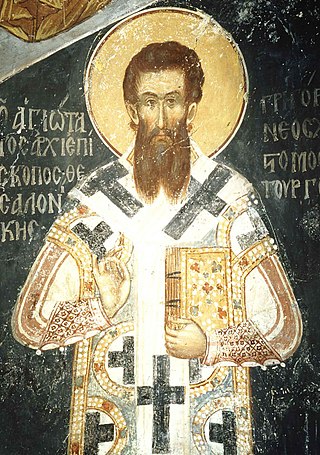
Gregory Palamas was a Byzantine Greek theologian and Eastern Orthodox cleric of the late Byzantine period. A monk of Mount Athos and later archbishop of Thessaloniki, he is famous for his defense of hesychast spirituality, the uncreated character of the light of the Transfiguration, and the distinction between God's essence and energies. His teaching unfolded over the course of three major controversies, (1) with the Italo-Greek Barlaam between 1336 and 1341, (2) with the monk Gregory Akindynos between 1341 and 1347, and (3) with the philosopher Gregoras, from 1348 to 1355. His theological contributions are sometimes referred to as Palamism, and his followers as Palamites.

Gennadius II was a Byzantine Greek philosopher and theologian, and Ecumenical Patriarch of Constantinople from 1454 to 1464. He was a strong advocate for the use of Aristotelian philosophy in the Orthodox Church.
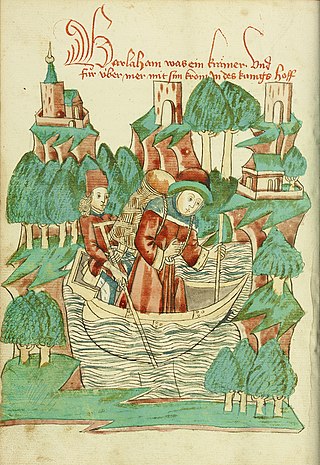
Barlaam of Seminara, c. 1290–1348, or Barlaam of Calabria was a Basilian monk, theologian and humanistic scholar born in southern Italy. He was a scholar and clergyman of the 14th century, as well as a humanist, philologist and theologian.

The House of Palaiologos, also found in English-language literature as Palaeologus or Palaeologue, was a Byzantine Greek family that rose to nobility and produced the last and longest-ruling dynasty in the history of the Byzantine Empire. Their rule as Emperors and Autocrats of the Romans lasted almost two hundred years, from 1259 to the Fall of Constantinople in 1453.
Fifth Council of Constantinople is a name given to a series of six councils held in the Byzantine capital Constantinople between 1341 and 1351, to deal with a dispute concerning the mystical doctrine of Hesychasm. These are referred to also as the Hesychast councils or the Palamite councils, since they discussed the theology of Gregory Palamas, whom Barlaam of Seminara opposed in the first of the series, and others in the succeeding five councils.

Mark of Ephesus was a hesychast theologian of the late Palaiologan period of the Byzantine Empire who became famous for his rejection of the Council of Ferrara-Florence (1438–1439). As a monk in Constantinople, Mark was a prolific hymnographer and a follower of Gregory Palamas' theological views. As a theologian and a scholar, he was instrumental in the preparations for the Council of Ferrara-Florence, and as Metropolitan of Ephesus and delegate for the Patriarch of Alexandria, he was one of the most important voices at the synod. After renouncing the council as a lost cause, Mark became the leader of the Orthodox opposition to the Union of Florence, thus sealing his reputation as a defender of Eastern Orthodoxy and pillar of the Eastern Orthodox Church.
Kallistos I was the Ecumenical Patriarch of Constantinople for two periods from June 1350 to 1353 and from 1354 to 1363. Kallistos I was an Athonite monk and supporter of Gregory Palamas. He died in Constantinople in 1363.
Demetrios Kydones, Latinized as Demetrius Cydones or Demetrius Cydonius, was a Byzantine Greek theologian, translator, author and influential statesman, who served an unprecedented three terms as Mesazon of the Byzantine Empire under three successive emperors: John VI Kantakouzenos, John V Palaiologos and Manuel II Palaiologos.
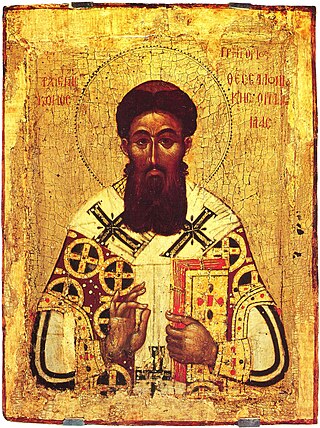
Palamism or the Palamite theology comprises the teachings of Gregory Palamas, whose writings defended the Eastern Orthodox practice of Hesychasm against the attack of Barlaam. Followers of Palamas are sometimes referred to as Palamites.

The Byzantine Empire was ruled by the Palaiologos dynasty in the period between 1261 and 1453, from the restoration of Byzantine rule to Constantinople by the usurper Michael VIII Palaiologos following its recapture from the Latin Empire, founded after the Fourth Crusade (1204), up to the Fall of Constantinople to the Ottoman Empire. Together with the preceding Nicaean Empire and the contemporary Frankokratia, this period is known as the late Byzantine Empire.

John XIV, surnamed Kalekas was the Ecumenical Patriarch of Constantinople from 1334 to 1347. He was an anti-hesychast and opponent of Gregory Palamas. He was an active participant in the Byzantine civil war of 1341–1347 as a member of the regency for John V Palaiologos, against John VI Kantakouzenos.
Isidore I was the Ecumenical Patriarch of Constantinople from 1347 to 1350. Isidore Buchiras was a disciple of Gregory Palamas.

The Byzantine Empire, also referred to as the Eastern Roman Empire, was the continuation of the Roman Empire primarily in its eastern provinces during Late Antiquity and the Middle Ages, when its capital city was Constantinople. It survived the fall of the Western Roman Empire in the 5th century AD and continued to exist until the fall of Constantinople to the Ottoman Empire in 1453. During most of its existence, the empire remained the most powerful economic, cultural, and military force in the Mediterranean world. Its citizens continued to refer to their empire as the Roman Empire and to themselves as Romans—a term which Greeks continued to use for themselves into Ottoman times. Modern historians distinguish the Byzantine Empire from the earlier Roman Empire due to the imperial seat moving from Rome to Byzantium, the Empire's integration of Christianity, and the predominance of Greek instead of Latin.
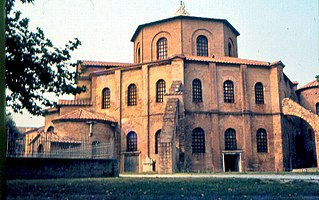
The Byzantine Papacy was a period of Byzantine domination of the Roman papacy from 537 to 752, when popes required the approval of the Byzantine Emperor for episcopal consecration, and many popes were chosen from the apocrisiarii or the inhabitants of Byzantine-ruled Greece, Syria, or Sicily. Justinian I reconquered the Italian peninsula in the Gothic War (535–554) and appointed the next three popes, a practice that would be continued by his successors and later be delegated to the Exarchate of Ravenna.

The Hesychast controversy was a theological dispute in the Byzantine Empire during the 14th century between supporters and opponents of Gregory Palamas. While not a primary driver of the Byzantine Civil War, it influenced and was influenced by the political forces in play during that war. The dispute concluded with the victory of the Palamists and the inclusion of Palamite doctrine as part of the dogma of the Eastern Orthodox Church as well as the canonization of Palamas.
This is a timeline of the presence of Eastern Orthodoxy in Greece from 1204 to 1453. The history of Greece traditionally encompasses the study of the Greek people, the areas they ruled historically, as well as the territory now composing the modern state of Greece.
Martin Jugie was a French Roman Catholic Assumptionist and scholar born on May 3, 1878, in Paulhiac in south-western France.
References
- ↑ Browning, Robert (1992). The Byzantine Empire . CUA Press. p. 268.
- ↑ Cuomo, Andrea Massimo (2010), "La terza messa ambrosiana di natale tradotta in greco e commentata da Manuele Caleca", Ricerche Storiche sulla Chiesa Ambrosiana (in Italian), vol. 27, pp. 9–99
- ↑ Dennis, George T. (1977). The Letters of Manuel II Palaeologus. Washington D.C.: Dumbarton Oaks. pp. 74–78.
- ↑ Angold, Michael (2006). Eastern Christianity. Cambridge University Press. p. 71. ISBN 9780521811132.